The Sacred White Buffalo
The White Buffalo (Bison) is considered sacred to many Native Americans including the Sioux, Cherokee, Navaho, Lakota, and Dakota tribes. A story, now approximately 2,000 years old, tells of the White Buffalo Calf Woman (Ptesan Wi) and a Native American prophecy of peace and goodwill on earth. There are several variations of the story, but all tell of the same outcome with clear intent for Peace, Harmony, and Balance for all life living in the Earth Mother.
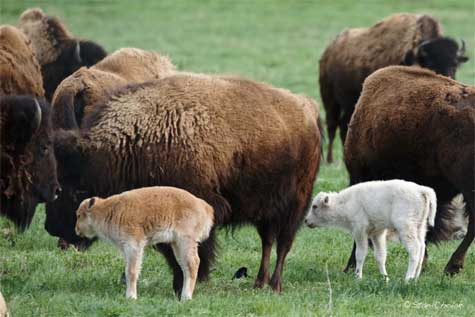
Is it really a sacred white buffalo or a man-made cattle hybrid?
Although feared and considered evil by some tribes such as the Comanche, generally speaking the arrival of a white buffalo calf is considered by many Native American tribes like the second coming of Christ - It will bring about purity of mind, body, and spirit and unify all nations - black, red, yellow, and white.
The white buffalo that was considered sacred to some Native American tribes was likely an albino or leucistic bison. Albinism in general is extremely rare in vertebrates, especially in mammals (1). Hence, albino bison would be extremely rare. So why are there now so many sacred animals around?
From pure white calves to blonde-cream colored cows and bulls - they seem to be everywhere. These animals are often highly prized and bring a premium at auctions and private sales, not only as novelty animals at zoos and tourist attractions but also bison ranchers and Indian tribes wanting one of the "sacred" spiritual animals.
But are these white bison really rare spiritual animals or simply remnants of man's dirty fingerprints and his experiments with cattalo in the early 1900's? With that in mind, I thought I might explain how these "sacred" animals occur and/or how you can have one too.
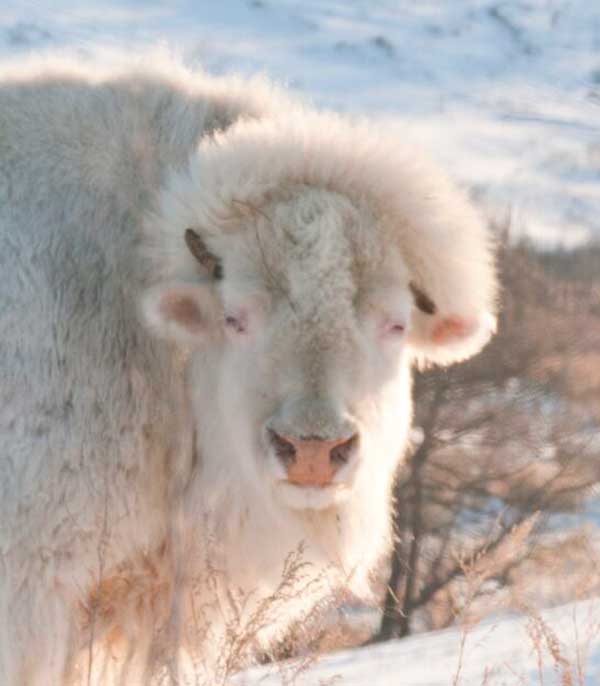
White Cloud. Notice the pink eyes, nose, and skin of a true albino bison.
There are potentially 3 types of white bison: Albinism, Leucism, and the Charolais SILV gene.
Albinism is the absence of any pigmentation or coloration resulting from a melanin deficiency. Albinos have melanocytes (the cells that make melanin), but do not produce melanin that is responsible for giving skin, hair, and eyes pigmentation. Thus, the albino has pure white fur and generally pink eyes and skin. This was likely the sacred white bison revered by some Native American Indians. Of the 30-60 million bison that once roamed the plains, there were probably very few albino bison among them. Recently there was an albino bison born and has since been propagated but remain exceptionally rare. There is a genetic test for albinism so be sure to test even if it has pink eyes and skin.
Leucism is an abnormal condition and hypopigmentary congenital disorder which causes white, pale, or patchy coloration of the hair that often indicates low levels of genetic diversity. Like albinism, complete leucism (complete loss of pigment, i.e., white animal) is very rare and few cases are reported in vertebrates. Animals with leucism generally have blue eye. Because leucism is caused by the complete or partial lack of melanocytes, it is often associated with other genetic disorders, particularly sensory organs and nerves. Complete leucism is also extremely rare in mammals.
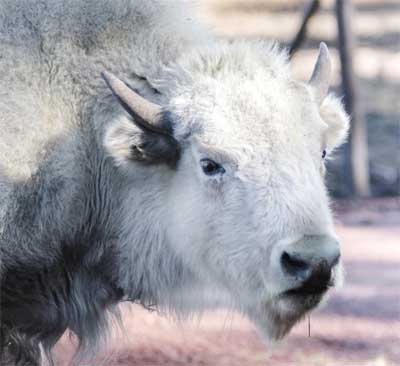
Bison calves with 2 copies of the SILV gene are born white but turn a blonde/cream color as they mature. The dark eyes are a giveaway that it is not an albino or leucistic animal but the result of Charolais SILV gene expression.
Although some "white" bison are claimed to be the result of leucism, there is no evidence to support these claims. Because of the known cattle introgression that occurred in the late 1800's-early 1900's, the documented presence of the Charolais SILV gene in bison, and the absence of any currently known cases of partial leucism (piebald) in bison raises seriously questions on the existence of leucism in bison. Any claim of a leucistic bison would need to be accompanied with confirmation that there is no evidence of cattle introgression or the Charolais SILV gene. Although leucism in bison could exist, there are no documented leucistic bison.
The Charolais mutation of the SILV (pronounced silver) dilution gene is the most common cause of "white" bison. This gene is usually a remnant of the bison-cattle hybrid (cattalo) experiments of the late 1800's and early 1900's, although there are a few farms that have recently created them from direct Charolais-bison crosses. These white bison hybrids are created by cross breeding back to bison through successive generations to increase the bison bloodline while retaining the color traits of the white Charolais cattle.
These bison are generally born white but turn cream/blonde as they mature. That is because the SILV mutation is not a white gene but a dilution gene; in other words, it dilutes out darker colors, both eumelanin (black pigment) and phaeomelanin (red pigment). While not really a recessive gene, it takes 2 copies of the SILV gene to create the white (blonde/cream) coat. There is also a Highland-Simmental-Galloway-Hereford dilution variant but these have not been identified in bison and do not generally produce a white hair coat. White bison with 2 copies of the Charolais SILV gene have normal appearing dark eyes and skin as opposed to the pink in albinism and blue in leucism. In addition, although considered "white", they will turn blonde/cream as they mature.

Typical blonde/cream color of a bison with 2 copies of the Charolais SILV gene. White bison often turn yellow-tan as they age.
Although hybrids, many still consider these "white" bison to be sacred animals because they seek the spiritual and prophetic experience of the white buffalo, do not realize they are cattle-bison hybrids and not really white, or simply don't care that they are hybrids and not white. Except for a few, most "white" bison herd owners will tell you that they are Charolais hybrids, but a few will claim they are pure bison. Some claim that, because all bison have cattle genes, which in itself is not true, that their "white" bison are therefore technically pure bison even though there is evidence of cattle introgression.
But what about the rancher that one day wakes up and finds, out of the blue, a white bison calf in his backyard. In 30 years he has never had a white calf born. How did this happen? Is it really a miracle? Is it that extremely rare true spiritual and scared white buffalo?
Absent the rare event of a true albino or leucistic animal, this is the scenario of how it usually happens:
You buy a perfectly normal appearing bull at auction or a private party to replace your old bull. For simplicity, he is the only herd sire. It could be a cow, but it would take longer to have the white calf appear. Unbeknown to you, sometime in his past ancestry, one of his grandparents was a Charolais cattle and he has a single copy of the Charolais SILV dilution gene. He may or may not have a slightly lighter coat than other bison, but not enough for you to take notice.
The bull breeds with the cows. Fifty percent (1/2) of all his offspring will carry the Charolais gene. His offspring will either be normal (N/N) or carriers (N/SILV). Assume the rancher sells off all his bull calves and keeps all or a few of the heifer calves. Unknowingly he has disseminated the Charolais SILV gene to other herds. In 2-years, his heifer calves (daughters) will be old enough to breed. If the bull breeds one of his daughter(s) that have the SILV (N/SILV) gene (50% of his original offspring) there is a 25% chance that the calf will be born white.
Mating his SILV daughter would produce either a normal calf (N/N), 2 carrier calves (SILV/N), or one white calf (SILV/SILV). Alternately and likewise, a sister-brother mating, both being carriers, would produce a white calf 25% of the time. If he had started with a carrier cow (N/SILV) or had more than one breeding bull, it would have been many more years before the right combination produced a white calf.
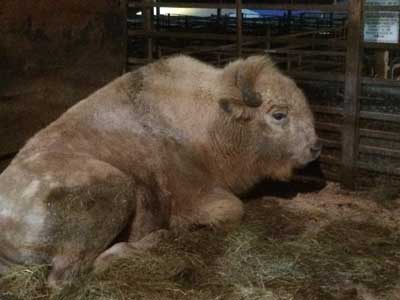
White bison bull offered for sale at the 2016 Missouri Bison Association Sale in Macon. This animal sold for over $7,000.
If you start with a direct Charolais-bison cross, you will need to go through about 15-20 successive generations breeding back to buffalo to increase the bison bloodline while retaining the color traits of the white Charolais. Simple genetic testing can greatly improve the efficiency of the back-crosses and speed up creating the "white bison".
From the above example you can see how a white calf or an entire white herd of bison can be produced, how the Charolais SILV gene is readily spread, and how it can be years before a white calf is actually produced particularly if you start with a cow rather than a bull. In the same scenario, without inbreeding, a rancher would never know the Charolais SILV gene was being propagated in his herd and sold to other unsuspecting breeders. It is also easy to note that these "white" animals are heavily inbred and likely suffer from low genetic diversity.
Once you have a white (blonde/cream) bull and cow, if they mate, they will always produce white calves and you can start creating your all white herd, albeit with some serious inbreeding and loss of diversity.
Of course there are other and quicker ways to produce a white herd or just a few "white" bison other than by chance. The quickest and easiest way would be to buy a "white" bull and a "white" cow, preferably from different farms, as they will breed true. The recent Missouri Bison Association auction offered such an opportunity. Alternately you can purchase a brown bison or two that are known to have been bred by a "white" bull. This animal will carry a single copy of the Charolais SILV gene. Since the Charolais SILV gene is easily detected with genetic testing, you can do some selective inbreeding to create your sacred animal or an entire herd of white animals.
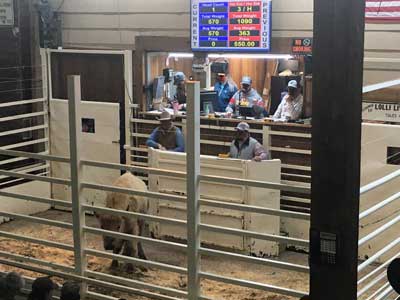
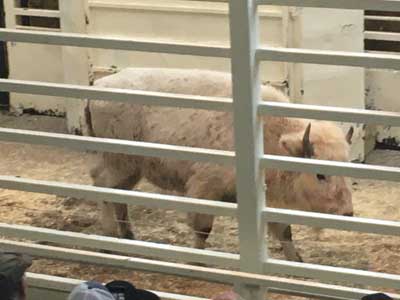
Yellow fat is not unique to bison. Notice the yellow fat of the grass-fed beef strip steak on the left as compared to the white fat of the grain fed steak on the right.
If you believe these hybrid "white" bison are spiritual and scared, you can visit them almost anywhere in the country. Complete white herds can be found in Athens County Ohio, Bend Oregon, Ingram Texas, and Rapid View Saskatchewan, Canada. If it is just a white buffalo you are looking for and not a complete herd, they can be seen in Northern Alberta; Sioux Valley, South Dakota; Winnipeg, Manitoba; Greenville, Texas; South Park, Colorado; Laona, Wisconsin; Goshen, Conn; Williams, Arizona; McGrath, Alaska; Luverne, Minnesota; Morristown, Tennessee; Port Clinton, Ohio; Avon, Minnesota; Rapid City, South Dakota; Hartsel, Colorado; Monterey, Tennessee, Uvalde, Texas; Cheboygan, Michigan; Donegal, Pennsylvania; Alleyton Texas; Denhoff, North Dakota; Seattle, Washington, and I am sure in other places I missed. In fact, there are even white bison in Belgrade, Serbia!
All of these places claim they possess the birth of one of the world's rarest animals - a spiritual and sacred white bison.

Recent genetically confirmed albino bison (photo courtesy of Trey Westre)
Although there are a few true albino bison out there, they are far and few between. All albino bison tested to date have the same tyrosinase (TYR) mutation suggesting very close relatedness (2). In addition, TYR mutations giving rise to albinism is common in cattle and studies to date have no looked at the influence of introgression on the existence of bison albinism. It is the owners of these "white" bison to provide the evidence that these are the real sacred animal and not just another hybrid. There is no excuse as the tests exist to differentiate between the Charolais SILV gene (with dark eyes and nose) and a TYR mutation (pink eyes, nose, and skin).
The downside, and hypocrisy, of it all is that most bison ranchers and producers have little regard or interest in whether or not their bison have evidence of cattle introgression as long as they are brown and look like a bison. But a white/blonde/cream colored bison, even if it has less evidence of cattle introgression that its brown brethren, are frowned upon as hybrids because they are phenotypically recognized. The National Bison Registry, upon information and belief, will accept animals into the registry with as many as 3 nuclear cattle introgression markers as long as they are brown, but will not accept a white bison into the registry regardless of the number of cattle introgression markers. Is this white bison any less a bison than the other brown hybrids that are ignored? That is the hypocrisy of it all.
Whether you believe all these "white" bison are spiritual and sacred animals revered by the Native American Indians of past or think they are just a reminder of our dirty fingerprints in the bison genome, the prevalence of the infamous "white bison" will continue to increase in the years ahead as long as there is indiscriminate breeding of bison.
Ozark Valley Bison Ranch LLC
Fox, AR
Literature Cited
1. McCardle, H. 2012. Albinism in wild vertebrates (Unpublished master's thesis). Texas State University-San Marcos, San Marcos, TX.
2. Stroupe S, Martone C, McCann B, et al. 2023. Chromosome-level reference genome for North American bison (Bison bison) and variant database aids in identifying albino mutation. G3 (Bethesda). 13:jkad156.
